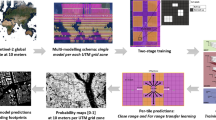Abstract
Nowadays, artificial neural networks (ANN) are models widely used in many areas; one of these is the classification of urban areas. This work aims to discuss a new framework for the delimitation of functional zones for the city of Naples through deep learning algorithms. More in detail, firstly, a segmentation approach is used to generate the urban zones from the satellite RGB image of interest; then, starting from an extrapolated OSM data, we develop a new labelled dataset used for the training of a convolutional neural network model. Finally, the urban zones are classified with a majority vote procedure. The innovative aspect of this methodology is the use of data provided for different purposes (that is, labelled OSM data) to compensate for the lack of data provided by experts in the field. For the experimentation, we compare two segmentation algorithms (FNEA and selective search) and three CNN models (AlexNet, ResNet-50 and a regularized version of AlexNet), providing good performances in the functional zone classification.




















Similar content being viewed by others
Explore related subjects
Discover the latest articles, news and stories from top researchers in related subjects.References
Baatz M, Schäpe A (2000) Multiresolution segmentation: an optimization approach for high quality multi-scale image segmentation
Farmakis I, Bonneau D, Hutchinson D et al (2020) Supervoxel-based multi-scale point cloud segmentation using FNEA for object-oriented rock slope classification using TLS. Int Arch Photogrammet Remote Sens Spat Inf Sci 43:1049–1056
He K, Zhang X, Ren S et al (2016) Deep residual learning for image recognition. In: Proceedings of the IEEE conference on computer vision and pattern recognition, pp 770–778
Hu T, Yang J, Li X et al (2016) Mapping urban land use by using landsat images and open social data. Remote Sens 8(2):151
Johnson JM, Khoshgoftaar TM (2019) Survey on deep learning with class imbalance. J Big Data 6(1):1–54
Krizhevsky A, Sutskever I, Hinton GE (2012) Imagenet classification with deep convolutional neural networks. Adv Neural Inf Process Syst 25:1097–1105
Kwan C, Ayhan B, Budavari B et al (2020) Deep learning for land cover classification using only a few bands. Remote Sens 12(12):2000
Li H, Ghamisi P, Rasti B et al (2020) A multi-sensor fusion framework based on coupled residual convolutional neural networks. Remote Sens 12(12):2067
Lv X, Ming D, Lu T et al (2018) A new method for region-based majority voting CNNS for very high resolution image classification. Remote Sens 10(12):1946
Montanges AP, Moser G, Taubenböck H et al (2015) Classification of urban structural types with multisource data and structured models. In: 2015 Joint urban remote sensing event (JURSE). IEEE, pp 1–4
Olofsson P, Foody GM, Stehman SV et al (2013) Making better use of accuracy data in land change studies: estimating accuracy and area and quantifying uncertainty using stratified estimation. Remote Sens Environ 129:122–131
Parhami B (1994) Voting algorithms. IEEE Trans Reliab 43(4):617–629
Shorten C, Khoshgoftaar TM (2019) A survey on image data augmentation for deep learning. J Big Data 6(1):1–48
Tong XY, Xia GS, Lu Q et al (2020) Land-cover classification with high-resolution remote sensing images using transferable deep models. Remote Sens Environ 237(111):322
Uijlings JR, Van De Sande KE, Gevers T et al (2013) Selective search for object recognition. Int J Comput Vis 104(2):154–171
Zhang X, Du S, Wang Q (2017) Hierarchical semantic cognition for urban functional zones with VHR satellite images and poi data. ISPRS J Photogrammet Remote Sens 132:170–184
Zhang X, Du S, Wang Q et al (2018) Multiscale geoscene segmentation for extracting urban functional zones from VHR satellite images. Remote Sens 10(2):281
Zhou W, Ming D, Lv X et al (2020) So-CNN based urban functional zone fine division with VHR remote sensing image. Remote Sens Environ 236(111):458
Author information
Authors and Affiliations
Corresponding author
Ethics declarations
Conflict of interest
The authors declare that they have no conflict of interest.
Additional information
Publisher's Note
Springer Nature remains neutral with regard to jurisdictional claims in published maps and institutional affiliations.
Rights and permissions
About this article
Cite this article
Izzo, S., Prezioso, E., Giampaolo, F. et al. Classification of urban functional zones through deep learning. Neural Comput & Applic 34, 6973–6990 (2022). https://doi.org/10.1007/s00521-021-06822-w
Received:
Accepted:
Published:
Issue Date:
DOI: https://doi.org/10.1007/s00521-021-06822-w





